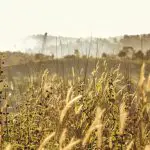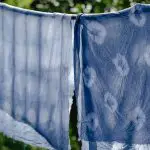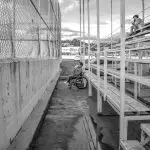Hey there, have you ever tried to put a Band-Aid on a cut that's still bleeding? That's kind of like laying landscape fabric over grass. It seems like a quick fix, but is it really effective?
Let's dive into the question: Is it possible to lay landscape fabric over grass? If you're looking to master the art of landscaping, you'll want to understand the potential benefits, drawbacks, and best practices before embarking on this endeavor.
We'll explore the impact on grass health, potential challenges, and alternative weed control methods for your green oasis.
So, grab a seat and let's uncover the truth about laying landscape fabric over grass.
Key Takeaways
- Reduced weed growth
- Improved moisture retention in the soil
- Grass may experience hindered natural growth and health
- Potential challenges with soil compaction, water and air circulation, and decreased soil fertility
Pros of Using Landscape Fabric Over Grass
When laying landscape fabric over grass, you can expect reduced weed growth and improved moisture retention in the soil. The fabric acts as a barrier, preventing weed seeds from reaching the soil and germinating, thus reducing the need for frequent weeding. Additionally, it helps to retain moisture in the soil by reducing evaporation, which is especially beneficial during hot and dry periods. This can lead to healthier plant growth and less water usage in the long run.
The effectiveness of landscape fabric in controlling weed growth and conserving soil moisture makes it a beneficial addition to your gardening or landscaping efforts. Its application is relatively simple – after preparing the area by mowing the grass short and removing any debris, the fabric can be laid out and secured with landscape fabric pins or staples. Once in place, it requires minimal maintenance, with occasional checks for any tears or shifting due to weather or foot traffic.
Cons of Laying Landscape Fabric Over Grass
You may occasionally encounter challenges when laying landscape fabric over grass. One of the main concerns is the potential for grass protection. While landscape fabric can effectively block sunlight and prevent weed growth, it can also hinder the natural growth and health of the existing grass. The fabric may prevent essential nutrients, water, and airflow from reaching the grass, leading to patchy or unhealthy grass over time. Additionally, if the fabric isn't installed properly, it can cause root disturbance. Grass roots may struggle to penetrate the fabric, leading to shallow root systems and making the grass more susceptible to drought and other stressors.
Another drawback of laying landscape fabric over grass is that it can be difficult to achieve a seamless and visually appealing result. The fabric may show through the grass, detracting from the overall aesthetic of the landscape. Moreover, if the grass isn't completely smothered by the fabric, it may eventually grow through the fabric, causing maintenance issues and requiring frequent adjustments.
Considering these potential drawbacks, it's essential to carefully weigh the pros and cons before deciding to lay landscape fabric over existing grass.
Potential Challenges When Using Landscape Fabric Over Grass
When laying landscape fabric over grass, you may encounter challenges such as grass regrowth underneath the fabric, soil compaction issues, and potential problems with water and air circulation.
These challenges can impact the effectiveness of the fabric and the overall health of your landscape.
It's important to consider these potential issues and plan accordingly to ensure the success of your landscaping project.
Grass Regrowth Underneath
To prevent potential challenges from grass regrowth underneath, consider using a high-quality landscape fabric. Proper grass management and lawn care are vital for ensuring that the fabric serves its purpose effectively. When choosing a landscape fabric, look for features such as UV resistance, permeability, and durability. Here's a table highlighting the key features to consider:
| Feature | Importance | Description |
|---|---|---|
| UV Resistance | High | Prevents degradation from sun exposure |
| Permeability | High | Allows water and nutrients to reach the soil |
| Durability | High | Resists tearing and degradation over time |
Selecting a landscape fabric with these features will help mitigate challenges related to grass regrowth underneath. Proper installation and regular maintenance will also contribute to the long-term success of using landscape fabric over grass.
Soil Compaction Issues
Landscape fabric can help prevent soil compaction issues that may arise when laying it over grass. However, there are potential challenges to consider:
- Decreased Soil Fertility: Over time, the use of landscape fabric can lead to reduced soil fertility due to the prevention of organic matter decomposition, which is essential for maintaining soil health and nutrient availability.
- Water Drainage Restrictions: Landscape fabric can impede water penetration, leading to poor drainage and potential waterlogging, which can further contribute to soil compaction issues.
- Root Growth Limitations: While landscape fabric can prevent grass regrowth, it may also restrict the expansion of plant roots, limiting their ability to access water and nutrients in the soil.
Careful consideration of these factors is essential when deciding whether to use landscape fabric over grass to mitigate soil compaction issues.
Water and Air Circulation
To address concerns from the previous subtopic, here are two key issues affecting grass when using landscape fabric: water and air circulation. When laying landscape fabric over grass, water retention and air circulation can become potential challenges. The fabric can hinder water penetration, leading to waterlogging and depriving the grass of essential moisture. Additionally, it may impede the exchange of air, resulting in poor aeration and potentially suffocating the grass roots. It's important to consider aeration methods to mitigate these issues, such as using perforated landscape fabric or incorporating small holes in the fabric to allow for water and air penetration. Here's a table summarizing the potential challenges and aeration methods:
| Potential Challenges | Aeration Methods |
|---|---|
| Water retention | Perforated landscape fabric |
| Air circulation | Small holes in the fabric |
Best Practices for Laying Landscape Fabric Over Grass
When laying landscape fabric over grass, consider mowing the grass as short as possible before applying the fabric. This step helps to minimize the potential for grass to grow through the fabric and compete with plants.
Here are some best practices for laying landscape fabric over grass:
- Grass Protection
- Use a sharp edging tool to create a clean border around the area where the fabric will be installed. This helps prevent grass from encroaching beneath the fabric.
- Consider using a biodegradable landscape fabric to allow for better soil and root interaction, which can benefit the overall health of the landscape.
- Maintenance Considerations
- Regularly monitor the landscape fabric for any signs of grass or weed growth. Promptly remove any intruding vegetation to prevent it from taking hold.
- Mulch over the landscape fabric to provide additional protection and help maintain a tidy appearance.
Following these best practices won't only protect the grass underneath but also contribute to the overall effectiveness of the landscape fabric in controlling weed growth and promoting plant health.
Impact on Grass Health and Growth
When you lay landscape fabric over grass, you risk suffocating the grass and hindering its growth. This can also impact the grass's access to essential nutrients and water, leading to potential health issues.
Additionally, the long-term health of the soil may be affected, which can further impact the overall growth and vitality of the grass.
Grass Suffocation Risk
You can expect grass suffocation to impact the health and growth of your lawn if landscape fabric is laid over it. This suffocation restricts soil aeration, leading to several negative effects on grass health and growth, including:
- Nutrient Deprivation: Grass suffocation reduces the availability of essential nutrients, hindering its ability to thrive.
- Moisture Retention: The fabric impedes the natural moisture flow, potentially causing waterlogging and root rot.
- Stunted Growth: With limited access to air and essential resources, the grass may struggle to grow, leading to a weakened and sparse lawn.
It's crucial to consider these factors before laying landscape fabric over grass to ensure the long-term health and vitality of your lawn.
Nutrient and Water Access
Once landscape fabric is laid over grass, the restriction of nutrient and water access can significantly impact the health and growth of your lawn.
The fabric inhibits the grass's ability to absorb essential nutrients from the soil and can lead to root competition. Nutrient absorption is crucial for the grass to thrive and maintain its lush green color.
With landscape fabric covering the grass, water penetration is also limited, affecting the grass's hydration and overall health. As a result, the grass may struggle to grow and spread effectively, leading to patchy or unhealthy-looking areas in your lawn.
Careful consideration should be taken when using landscape fabric over grass to ensure that nutrient and water access isn't compromised, as it directly impacts the well-being and growth of your lawn.
Long-Term Soil Health
To maintain long-term soil health and promote optimal grass growth, it's essential to consider the impact of landscape fabric on nutrient availability and root development.
When it comes to long-term soil health and grass maintenance, landscape fabric can have implications for soil fertility and the overall well-being of your grass. Here's what you need to consider:
- Soil Fertility: Landscape fabric can affect the natural decomposition of organic matter, potentially impacting soil fertility over time.
- Nutrient Availability: The fabric may impede the natural process of nutrient cycling, affecting the availability of essential nutrients for grass growth.
- Root Development: Grass roots require adequate space and nutrient access for healthy growth.
- Soil Compaction: Landscape fabric may lead to soil compaction, hindering root penetration and development.
- Microbial Activity: It can also impact the beneficial microbial activity essential for soil health and root development.
Tips for Installing Landscape Fabric Over Grass
When installing landscape fabric over grass, consider mowing the grass as short as possible before laying the fabric. This will help create a smoother surface for the fabric and reduce the chances of the grass growing through it. Additionally, here are some tips to ensure a successful installation:
| Tip | Description |
|---|---|
| Use Heavy-Duty Fabric | Opt for a landscape fabric with high grass protection and fabric durability. This will prevent weed penetration and ensure the fabric lasts longer. |
| Overlap Edges and Secure Well | Overlapping the edges of the fabric by at least 6 inches and securing them with fabric pins or staples will provide better coverage and prevent weed growth between the seams. |
| Add Mulch or Gravel on Top | After laying the fabric, adding a layer of mulch or gravel on top can further enhance weed control and improve the aesthetics of the area. |
Following these tips will help you effectively install landscape fabric over grass, providing long-term protection for your landscape while minimizing maintenance needs.
Alternative Weed Control Methods for Grass
You frequently encounter weeds in your grass, and implementing alternative control methods can help manage them effectively. When it comes to maintaining a weed-free lawn without resorting to chemicals or landscape fabric, there are several natural alternatives and grass-friendly solutions you can consider:
- Mulching: Applying a layer of organic mulch such as wood chips or shredded leaves can help suppress weed growth by blocking sunlight and preventing weed seeds from germinating. This method also enriches the soil as the mulch decomposes.
- Hand Pulling: Although it requires some effort, hand pulling weeds is an effective way to control them without harming your grass. Ensure you pull the entire weed, including the roots, to prevent regrowth.
- Vinegar Solution: A mixture of vinegar, water, and a small amount of dish soap can be used as a natural weed killer. Be cautious when applying it, as it can also harm desired plants. This method is best for spot treatments.
Frequently Asked Questions
Can Landscape Fabric Be Used Over Grass to Prevent Weed Growth Without Harming the Grass?
Yes, landscape fabric can be used over grass to prevent weed growth without harming the grass. It provides ground protection and weed prevention while maintaining grass health. Ensure proper installation for grass compatibility.
How Does Landscape Fabric Affect the Natural Drainage of Water in the Grass?
Landscape fabric can impact water drainage in grass by inhibiting natural percolation, potentially causing water pooling and soil compaction. This can affect grass health and root development, so it's important to consider proper drainage when using landscape fabric over grass.
Will Laying Landscape Fabric Over Grass Make It Difficult to Mow the Lawn?
Laying landscape fabric over grass can make mowing challenging as the fabric installation can hinder easy maneuvering. It may also affect grass maintenance, causing concerns about proper growth and health.
Are There Any Specific Types of Grass That Are More Compatible With Landscape Fabric?
When considering types of grass, it's important to choose ones that are compatible with landscape fabric. Different varieties have different root structures, so select grass that won't be hindered by fabric installation.
Can Landscape Fabric Be Used Over Grass in Areas With Heavy Foot Traffic or Play Areas?
You can lay landscape fabric over grass in high-traffic or play areas to prevent weeds and protect the grass. Choose grass types that are compatible with landscape fabric and ensure proper installation for best results.
- Tetron Fabric for Marine Applications: Durability and Use Cases - June 18, 2025
- Tetron Fabric for Outdoor Furniture: Weather Resistance and Care - June 18, 2025
- Tetron Fabric for Wall Coverings: Style and Application Tips - June 18, 2025







